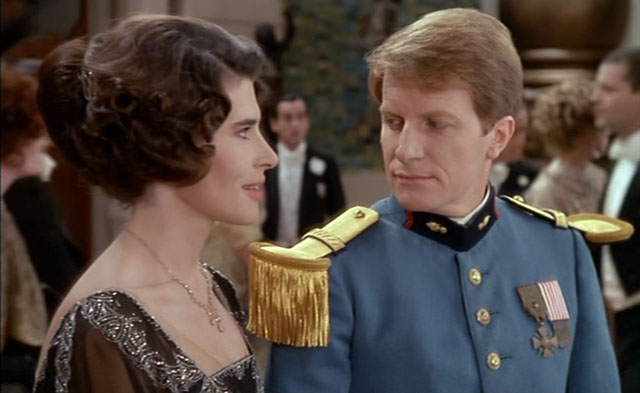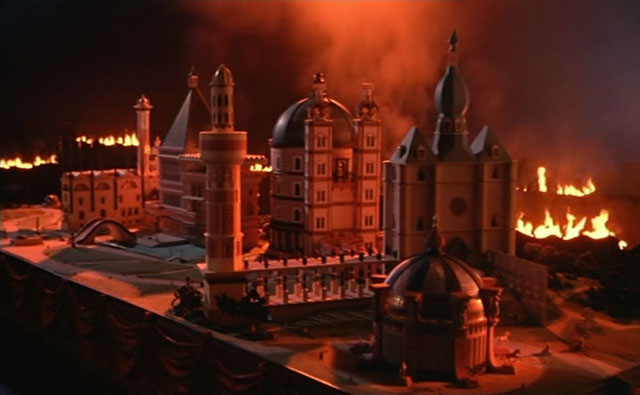Stories don’t just lead into each other like in The Saragossa Manuscript – they melt and morph into each other, thanks to codirector Evan Johnson’s digital manipulations, which don’t replace Maddin’s usual bag of tricks, but join the choppy editing and texture fetish and everything else. Some of his early movies had somnambulist rhythms, but this one is ecstatic from start to finish.

Had to watch this a couple times before I could report in.
Second time through, I noted the order of stories:
How to Take a Bath, with Louis Negin
Submarine: Blasting Jelly and Flapjacks
Starring Negin again with Ukranian Greg Hlady, panicky Alex Bisping, Andre the Giant-reminiscent Kent McQuaid, and mysteriously-appearing woodsman Cesare (Roy Dupuis of Mesrine and Screamers).
M. Sicinski:
Like the men in the submarine, The Forbidden Room has an overall mood of anxiety and despair, in the sense that we are asked to grapple with its heady delirium of character trajectories and stunted arcs, all the while searching in vain for some absent center, the organizing “captain” who is supposed to pull it all together. In its endless ruptures and disconnections, The Forbidden Room brings us up short, placing us back in that capsule where the image is a form of confinement, a shortness of breath.
Cowardly Saplingjacks
Cesare sets out to rescue the kidnapped Margo (Clara Furey)

Cave of the Red Wolves
with lead wolf Noel Burton, bladder slapping and boggling puzzlements!

Amnesiac Singing Flowergirl
Margo again, with mysterious necklace woman Marie Brassard (sinister Jackie from Vic + Flo Saw a Bear) and patient Pancho (Victor Andres Trelles Turgeon)
The Final Derriere
with Sparks, Udo Kier (returning from Keyhole) as a man plagued by bottoms, Master Passion Geraldine Chaplin, and the Lust Specialist (Le Havre star Andre Wilms)


Red Wolves / Woodsmen / Submarine / Bath / Submarine
Quick return.
Squid Theft / Volcano Sacrifice
With Margo, squid thief Romano Orzari and Lost Generation attorney Céline Bonnier (The Far Side of the Moon)
D. Ehrlich:
The Forbidden Room may (or may not) be inventing narratives from thin air, but whatever history these abandoned projects might have had is completely supplanted by the present Maddin (and co-director Evan Johnson) invents for them. These stories belong to him now. The Forbidden Room may forego the hypnotically autobiographical thrust of recent efforts like My Winnipeg and Brand Upon the Brain!, but it feels no less personal for it.
Mill Seeks Gardener
With shed-sleeper Slimane Dazi and unpredictable runaway Jacques Nolot

Injured Motorcyclist at Bone Hospital
Caroline Dhavernas and Paul Ahmarani
Doctor kidnapped by skeleton insurance defrauders
Lewis Furey (Margo’s father IRL) as The Skull-Faced Man, and Eric Robidoux as the bone doctor’s long-lost brother who is also a bone doctor.
Psychiatrist and madman aboard train
Gregory Hlady again, Romano Orzari again, and Karine Vanasse (Polytechnique) as Florence LaBadie


Florence’s Inner Child
Sienna Mazzone as young Florence with crazy mother Kathia Rock

Parental Neglect / Madness / Murder / Amnesia

Bone Hospital / Insurance Defrauders
Mill / Criminal / Doctor
Volcanic Island / Squid Theft / Submarine / Bath
“I haven’t finished telling you: the forest… the snow… the convict… the birthday”
Woodsman Gathers New Allies
Kyle Gatehouse as Man With Upturned Face, Neil Napier as Man With Stones On His Feet and Victor Turgeon again as Listening Man – these are the same actors who played the Saplingjacks earlier, and again they don’t enter the cave with Cesare.
Margo and Aswang The Vampire
M. D’Angelo:
The Forbidden Room was shot mostly at the Centre Georges Pompidou in Paris, piecemeal, in front of a live audience, following which Maddin and Johnson artfully distressed the digital footage and added priceless intertitles. The project took advantage of whichever actors were available to it on a given day.
Elevator Man Unprepared For Wife’s Birthday Kills His Butler
All-star segment with Mathieu Amalric, Udo Kier and Amira Casar (Anatomy of Hell, Piano Tuner of Earthquakes).
D. Ehrlich:
[Amalric] gleefully indulges in Maddin’s pure and peerlessly florid sense of melodrama, which here becomes a mechanism for foolhardy and paranoid men to ruin their lives as they attempt to rescue, love, or murder the beautiful women who didn’t ask for their help.
Dead Butler Oedipal Mustache Flashback
Maybe my favorite segment, with Maria de Medeiros (Saddest Music in the World) as the Blind Mother and more mentions of flapjacks.


Ukranian Radio War Drama
With Stranger by the Lake star Christophe Paou as the prisoner
Mustache / Return of the Dead Father
Diplomat Memoirs of Cursed Janus-Head
M. Peranson:
Together, Maddin and Johnson have crafted a formal masterwork jolted by digital after effects, recreating the look of decaying nitrate stock, shape-shifting the image with multiple superimpositions and variegated colour fields (the general look resembling decayed two-strip Technicolor), and compositing swirling transitions that connect (or bury) one film within the other (and the other, and the other). To try and describe “what happens” in The Forbidden Room is both forbidding and beside the point, for the 130-minute film stands more as an interminable, (in)completed object on its own, like the work of one of its main influences, the French poet, novelist and playwright Raymond Roussel (from whom Maddin and Johnson borrow their technique of parenthetical asides); one comes to understand this object, and what it’s trying to accomplish, only while watching it.
Peranson’s writeup is from the Toronto Film Festival, after which nine minutes got removed from the movie. Since nobody at the festivals was able to exhaustively account for all the stories within stories, it’s impossible to track down what got lost. It seems, though, that any lost footage (and more) can be seen in the Seances.
Andreas Apergis and his fiancee Sophia Desmarais (Curling)
Night Auction Doppelganger
featuring LUG-LUG, hideous impulse incarnate!

Stealing Mother’s Laudanum
Charlotte Rampling as Amalric’s Mother, Ariane Labed (Attenberg, Alps) as his girlfriend.
Maddin (in an essential Cinema Scope interview) on the film’s 2+ hour length:
We could have easily had a 75-minute version … but viewers that like it, we wanted to feel like we’d broken their brains, really left a physical impression on them, left them exhausted. Hopefully exhilarated and exhausted, in a good way. We wanted “too much” to still be insufficient … it would be nice if it came out in one endless ribbon, that, like John Ashbery’s poetry, you just snip off for a beginning and an end, and just ask the audience how much they want.
Dead Father / Elevator Birthday Murder Plot / Margo and Aswang / Woodsmen
Red Wolves are Dead, Rescue is Cancelled
Submarine / The Forbidden Room / Book of Climaxes


Bath.
–
April 2022: watched the blu-ray – the ambient-morphy extras and the commentary. This included Once a Chicken, which I didn’t realize at the time is considered a short film, I thought it was more motion-posters… all overlapping images and no Louis Negin.
Guy: “I’ve long been … making movies about things I don’t know anything about and refuse to do research on.” This wasn’t shot on stage in front of an audience like I imagined, was shot “in public” in foyers and such. Each morning the actors were all put into a trance, I think I knew this. Maddin wants to go on a self-loathing party, as usual. “I think Udo is a real-life Bond villain.” Sparks wrote, recorded and delivered “The Final Derriere” in five hours. The lost movies they’re adapting-in-spirit include Allan Dwan’s 1915 The Forbidden Room, Greek musical The Fist of a Cripple, Chinese film Women Skeletons, a Blue Mountains Mystery from Australia, Murnau’s version of the Jekyll & Hyde story, and Alice Guy’s Dream Woman.














































